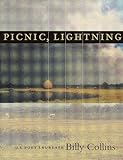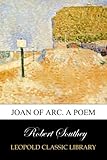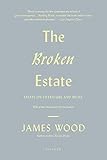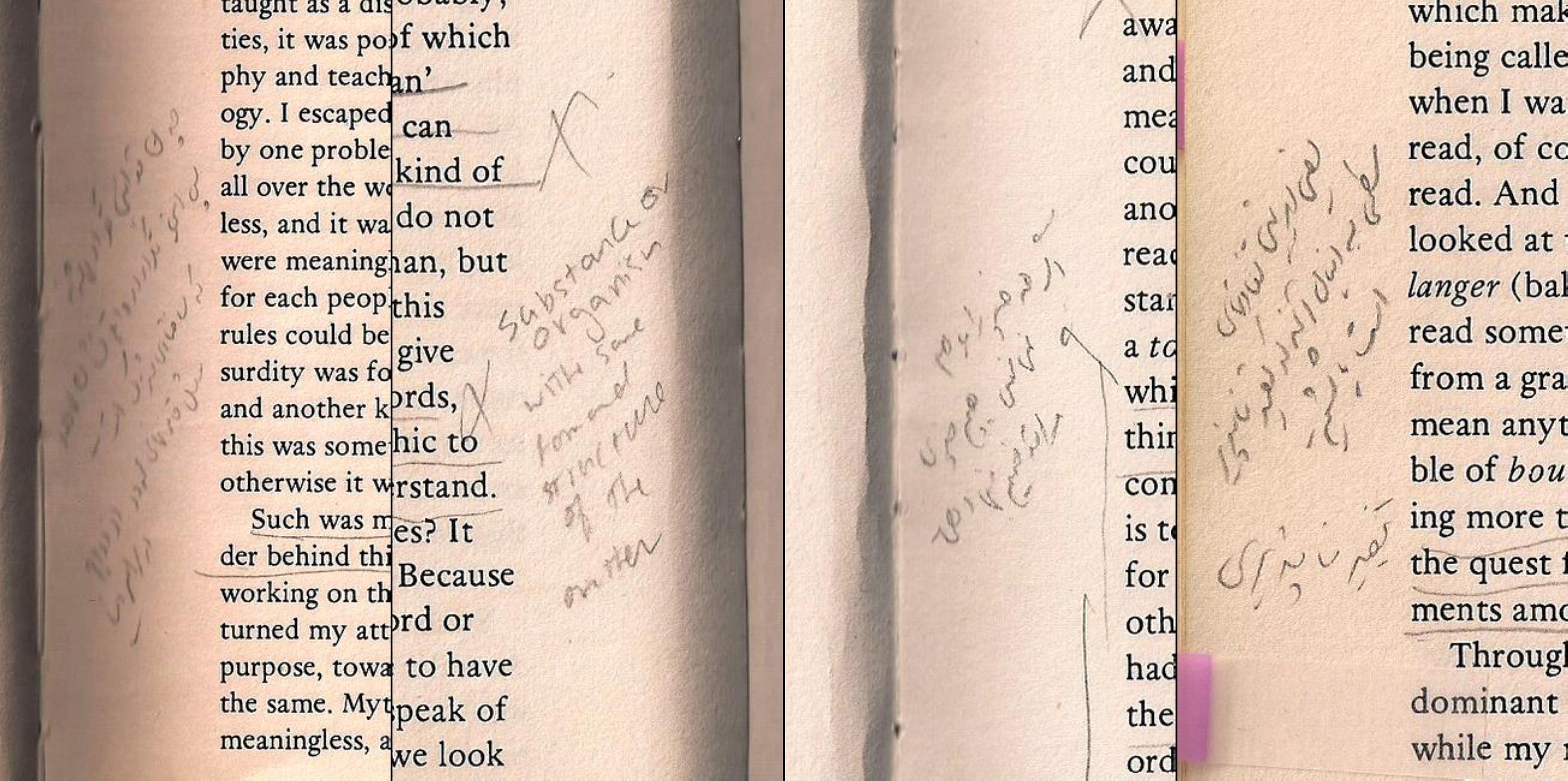“We have all seized the white perimeter as our own,” wrote Billy Collins in “Marginalia.” (When I first read the poem, I dutifully scored the passage with a checkmark in my copy of Picnic, Lightning — surely a meta-marginal inscription if there ever was one.) Collins’s words, jubilant, even triumphal, may strike the seasoned marginalist as overly dramatic, if not absurd; however, lest we forget, the tyranny of “the white perimeter” is not easily repealed in those whom it has been cultivated. Our culture is less than forbearing in matters of extra-textual scribbling, its very presence analogous to vandalism or, perhaps worse, the intellectual’s vague sedition; our training, therefore, begins early. For a child overly fond of the library, the rituals of card and stamp and due date quickly (and, for some, permanently) accord the book a kind of material sanctity: to write in one would be akin to relieving oneself in the narthex. So we may forgive Collins his exuberance in conquering the margins (what he elsewhere refers to, quite beautifully, as having “planted an impression along the verge”); after all, when one has finally and irrevocably transgressed — say, a furtively penned “IRONY” in a battered copy of Oscar Wilde as a teenager — the act of reading opens like a paper flower dropped in water. The text, thus defaced, provoked, enriched, no longer appears as chantry but rather something approaching a bordello, a blackboard, a battleground.

 What do we know of the hidden life of this richly historical, eminently malleable literary practice? As we continue to inundate our texts with scratches, exes, pentagrams, aggressively enthusiastic exclamations, stains, imprints, and doodles, a parallel text, possessed of its own narrative thrust, begins to emerge. What are the stakes of this reading record that is somehow neither public nor private, but rather limbic, brazenly interstitial, a farrago of hieroglyphs, incantations, surfeits, and asides? Is marginalia, finally, truly marginal?
What do we know of the hidden life of this richly historical, eminently malleable literary practice? As we continue to inundate our texts with scratches, exes, pentagrams, aggressively enthusiastic exclamations, stains, imprints, and doodles, a parallel text, possessed of its own narrative thrust, begins to emerge. What are the stakes of this reading record that is somehow neither public nor private, but rather limbic, brazenly interstitial, a farrago of hieroglyphs, incantations, surfeits, and asides? Is marginalia, finally, truly marginal?
Mortimer J. Adler, in his seminal How to Read a Book, lays out the purview of marginalia thusly:
Why is marking a book indispensable to reading it? First, it keeps you awake — not merely conscious, but wide awake. Second, reading, if it is active, is thinking, and thinking tends to express itself in words, spoken or written. The person who says he knows what he thinks but cannot express it usually does not know what he thinks. Third, writing your reactions down helps you to remember the thoughts of the author.
There is much wisdom here, as in much of Adler, though that last sentence feels incomplete to me. If marginalia helps the reader “remember the thoughts of the author,” a far more important function, I think, is that it helps the reader remember her own resolves, her reactions, her quibbles and queries. It is a flash of insight or anger, ossified, trapped in literary amber where it can be retrieved for a later reckoning.

 A book, after all, is a form of confrontation, and one of the most compelling motivators behind marginalia is a kind of engaged hostility. This quarrelsome brand of literary corrective, whether a byproduct of zealous critical engagement or the basest jealousy, is both compulsively readable and often very funny. Samuel Taylor Coleridge, whose collected marginalia runs to six volumes, took such a disliking to Robert Southey’s Joan of Arc that he created a kind of abusive shorthand to deploy at will in the guilty margins: the New York Public Library, which owns the Berg Collection of which this text is a part, lists “J” (a “discordant jingle of sound”), “L.M.” (“ludicrous metaphor”), and “S.E.” (“Southey’s English,” an idiom which, apparently, exasperated Coleridge), among a great many others. Similarly adversarial, though more judicious in the levying, was David Markson, whose light checkmarks and fragmented erudition belied a forcible literary temper. Next to a particular passage in Don DeLillo’s Mao II — “That the withheld work of art is the only eloquence left” — the late novelist wrote, rather eloquently it must be said, “Bullshit.”
A book, after all, is a form of confrontation, and one of the most compelling motivators behind marginalia is a kind of engaged hostility. This quarrelsome brand of literary corrective, whether a byproduct of zealous critical engagement or the basest jealousy, is both compulsively readable and often very funny. Samuel Taylor Coleridge, whose collected marginalia runs to six volumes, took such a disliking to Robert Southey’s Joan of Arc that he created a kind of abusive shorthand to deploy at will in the guilty margins: the New York Public Library, which owns the Berg Collection of which this text is a part, lists “J” (a “discordant jingle of sound”), “L.M.” (“ludicrous metaphor”), and “S.E.” (“Southey’s English,” an idiom which, apparently, exasperated Coleridge), among a great many others. Similarly adversarial, though more judicious in the levying, was David Markson, whose light checkmarks and fragmented erudition belied a forcible literary temper. Next to a particular passage in Don DeLillo’s Mao II — “That the withheld work of art is the only eloquence left” — the late novelist wrote, rather eloquently it must be said, “Bullshit.”
The margins, too, are often used to democratize a reader’s engagement with the text, to level the playing field as it were so that the act of reading becomes a form of robust conversation, something vigorous that approaches an act of interrogation. David Foster Wallace’s annotated books, in which his slanting words are corralled into labyrinthine honeycombs of red-penned shapes, are a fine example of this readerly dynamism. His blooming bubbles of thought, copious to the point of claustrophobia, can have the not unpleasant effect of literary vertigo: who is writing in whose margins here? Which is text and which is commentary? Wallace, of course, employs what is merely an outsized mode of what, I think, most readers use the margins for: that is, a piercing of the veil, a textual cohabitation in which lulling passivity is shed. No longer content with mere perusal, we become enabled participants, capable and correcting, or else fierce and fiery lovers, leaving notes we hope the author — or some distant reader — will linger over.
And herein we stumble upon one of the most intimate and empathetic dimensions of marginalia: that it is often a form of failed privacy. When we mark our books, we affix a particular meaning to a text-in-time, one meant for, at the very least, a temporally inaccessible self — though in my own reading, the intended recipient is often a figment of literary fantasy. I converse with the dead, with strangers who may own this book in the far flung future on whom I wish to make a striking impression. Or, admittedly discomfiting, I sometimes aim to astound myself 10 years hence, an eerie longing for the adoration of my own eyes grown older. I do not do these things consciously (or, at least, not always); rather, it would appear that in my own marginalia, desire is an animating principle, a need to relate — or to prove something — to figures not living, not present, not born.
Alternately, who hasn’t succumbed to the delicious voyeurism of a stranger’s scrawlings? In following along with the previous reader’s checks and brackets, their snarks and synopses, their tangents and revelations, we read a text doubly, illumined by the spectral presence of past engagement. Used bookstores are graveyards of casual epiphanies, awaiting the resurrective animism of fresh consciousness. And whether we are of like mind with the erstwhile owner or we find ourselves adversaries in interpretation, it is a literary haunting the seductive power of which depends on the worth of its abandoned concealments.
And, too, how confidently we build physical profiles and intellectual dossiers based solely on these laconic remnants. Outstripping obscurity, their marks remain generative, capable of a surprisingly rich composition. A character materializes before us: spotted scalp, natty loafers. The banalities of life discoloring the page — a spot of coffee, an egg salad stain — achieve an eloquence difficult to explain. We scorn their misspelled words. We admire their lyrical wit. We marvel at the decades-old Sear’s coupon doubled over in the book’s yellowed center. We wince where pens ran dry, a familiar frustration in the empty spirals pressed against the page; a new color (we pronounce judgment on their choice) begins its work. More present, more articulate ghosts we will not find.
 If, as James Wood has it in The Broken Estate, “every book is its own reality and its own realism,” marginalia grants us a footpath back to our reality. It renders the passage fluid between book and life, a floodlit corridor through which we might transport and retain our hard-won insights. These humble marks are the seams and scars borne in the service of reading, the places wherein we rushed heedlessly toward a ripple, an intuited glimmer. Taken together, they comprise a kind of atlas of interest, a map of literature’s ability to quicken the opaque substance of the reading mind. Bequeathing our words, we bequeath ourselves: there, lit up suddenly, a life inscribed.
If, as James Wood has it in The Broken Estate, “every book is its own reality and its own realism,” marginalia grants us a footpath back to our reality. It renders the passage fluid between book and life, a floodlit corridor through which we might transport and retain our hard-won insights. These humble marks are the seams and scars borne in the service of reading, the places wherein we rushed heedlessly toward a ripple, an intuited glimmer. Taken together, they comprise a kind of atlas of interest, a map of literature’s ability to quicken the opaque substance of the reading mind. Bequeathing our words, we bequeath ourselves: there, lit up suddenly, a life inscribed.
Image Credit: Flickr/uair01.









